Monitoring Total Suspended Solids and Chlorophyll-a Concentrations in Turbid Waters: A Case Study of the Pearl River Estuary and Coast Using Machine Learning
Abstract
:1. Introduction
2. Materials and Methods
2.1. Study Area
2.2. In Situ Data
2.3. Satellite Data and Preprocessing
2.4. Match-Up Analysis
2.5. Modeling
2.6. Accuracy Evaluation
2.7. Summary
3. Results
3.1. Evaluation of Machine Learning Algorithms
3.2. Long-Term Water Quality in the PRE
3.2.1. Spatial Distribution
3.2.2. Seasonal Variations
3.3. Impact of HZMB on Surrounding Water Quality
4. Discussion
4.1. Comparison of XGBoost-Based Algorithms with the Existing Algorithms
4.2. Performance of the Algorithm at Different Concentrations
5. Conclusions
Author Contributions
Funding
Data Availability Statement
Acknowledgments
Conflicts of Interest
Appendix A
References
- Harding, L.W.; Mallonee, M.E.; Perry, E.S. Toward a Predictive Understanding of Primary Productivity in a Temperate, Partially Stratified Estuary. Estuar. Coast. Shelf Sci. 2002, 55, 437–463. [Google Scholar] [CrossRef]
- Guo, J.; Ma, C.; Ai, B.; Xu, X.; Huang, W.; Zhao, J. Assessing the Effects of the Hong Kong-Zhuhai-Macau Bridge on the Total Suspended Solids in the Pearl River Estuary Based on Landsat Time Series. J. Geophys. Res. Ocean. 2020, 125, e2020JC016202. [Google Scholar] [CrossRef]
- Barbier, E.B.; Hacker, S.D.; Kennedy, C.; Koch, E.W.; Stier, A.C.; Silliman, B.R. The Value of Estuarine and Coastal Ecosystem Services. Ecol. Monogr. 2011, 81, 169–193. [Google Scholar] [CrossRef]
- Sari, V.; Dos Reis Castro, N.M.; Pedrollo, O.C. Estimate of Suspended Sediment Concentration from Monitored Data of Turbidity and Water Level Using Artificial Neural Networks. Water Resour. Manag. 2017, 31, 4909–4923. [Google Scholar] [CrossRef]
- Liu, F.; Zhang, T.; Ye, H.; Tang, S. Using Satellite Remote Sensing to Study the Effect of Sand Excavation on the Suspended Sediment in the Hong Kong-Zhuhai-Macau Bridge Region. Water 2021, 13, 435. [Google Scholar] [CrossRef]
- Zhang, X.; Huang, J.; Chen, J.; Zhao, Y. Remote Sensing Monitoring of Total Suspended Solids Concentration in Jiaozhou Bay Based on Multi-Source Data. Ecol. Indic. 2023, 154, 110513. [Google Scholar] [CrossRef]
- Harris, C.K. Across-Shelf Sediment Transport: Interactions between Suspended Sediment and Bed Sediment. J. Geophys. Res. 2002, 107, 3008. [Google Scholar] [CrossRef]
- Bilotta, G.S.; Brazier, R.E. Understanding the Influence of Suspended Solids on Water Quality and Aquatic Biota. Water Res. 2008, 42, 2849–2861. [Google Scholar] [CrossRef] [PubMed]
- Dai, Y.; Yang, S.; Zhao, D.; Hu, C.; Xu, W.; Anderson, D.M.; Li, Y.; Song, X.-P.; Boyce, D.G.; Gibson, L.; et al. Coastal Phytoplankton Blooms Expand and Intensify in the 21st Century. Nature 2023, 615, 280–284. [Google Scholar] [CrossRef]
- Paerl, H.W. Assessing and Managing Nutrient-Enhanced Eutrophication in Estuarine and Coastal Waters: Interactive Effects of Human and Climatic Perturbations. Ecol. Eng. 2006, 26, 40–54. [Google Scholar] [CrossRef]
- Deng, T.; Chau, K.-W.; Duan, H.-F. Machine Learning Based Marine Water Quality Prediction for Coastal Hydro-Environment Management. J. Environ. Manag. 2021, 284, 112051. [Google Scholar] [CrossRef]
- Kravitz, J.; Matthews, M.; Bernard, S.; Griffith, D. Application of Sentinel 3 OLCI for Chl-a Retrieval over Small Inland Water Targets: Successes and Challenges. Remote Sens. Environ. 2020, 237, 111562. [Google Scholar] [CrossRef]
- Liu, G.; Li, L.; Song, K.; Li, Y.; Lyu, H.; Wen, Z.; Fang, C.; Bi, S.; Sun, X.; Wang, Z.; et al. An OLCI-Based Algorithm for Semi-Empirically Partitioning Absorption Coefficient and Estimating Chlorophyll a Concentration in Various Turbid Case-2 Waters. Remote Sens. Environ. 2020, 239, 111648. [Google Scholar] [CrossRef]
- Zhao, J.; Zhang, F.; Chen, S.; Wang, C.; Chen, J.; Zhou, H.; Xue, Y. Remote Sensing Evaluation of Total Suspended Solids Dynamic with Markov Model: A Case Study of Inland Reservoir across Administrative Boundary in South China. Sensors 2020, 20, 6911. [Google Scholar] [CrossRef] [PubMed]
- Wang, C.; Li, W.; Chen, S.; Li, D.; Wang, D.; Liu, J. The Spatial and Temporal Variation of Total Suspended Solid Concentration in Pearl River Estuary during 1987–2015 Based on Remote Sensing. Sci. Total Environ. 2018, 618, 1125–1138. [Google Scholar] [CrossRef] [PubMed]
- Kolluru, S.; Tiwari, S.P. Modeling Ocean Surface Chlorophyll-a Concentration from Ocean Color Remote Sensing Reflectance in Global Waters Using Machine Learning. Sci. Total Environ. 2022, 844, 157191. [Google Scholar] [CrossRef]
- Adjovu, G.E.; Stephen, H.; James, D.; Ahmad, S. Measurement of Total Dissolved Solids and Total Suspended Solids in Water Systems: A Review of the Issues, Conventional, and Remote Sensing Techniques. Remote Sens. 2023, 15, 3534. [Google Scholar] [CrossRef]
- Maier, H.R.; Dandy, G.C. Neural Networks for the Prediction and Forecasting of Water Resources Variables: A Review of Modelling Issues and Applications. Environ. Model. Softw. 2000, 15, 101–124. [Google Scholar] [CrossRef]
- McCabe, M.F.; Rodell, M.; Alsdorf, D.E.; Miralles, D.G.; Uijlenhoet, R.; Wagner, W.; Lucieer, A.; Houborg, R.; Verhoest, N.E.C.; Franz, T.E.; et al. The Future of Earth Observation in Hydrology. Hydrol. Earth Syst. Sci. 2017, 21, 3879–3914. [Google Scholar] [CrossRef] [PubMed]
- Sinha, A.; Abernathey, R. Estimating Ocean Surface Currents With Machine Learning. Front. Mar. Sci. 2021, 8, 672477. [Google Scholar] [CrossRef]
- Fan, Y.; Li, W.; Chen, N.; Ahn, J.-H.; Park, Y.-J.; Kratzer, S.; Schroeder, T.; Ishizaka, J.; Chang, R.; Stamnes, K. OC-SMART: A Machine Learning Based Data Analysis Platform for Satellite Ocean Color Sensors. Remote Sens. Environ. 2021, 253, 112236. [Google Scholar] [CrossRef]
- Ma, C.; Zhao, J.; Ai, B.; Sun, S.; Yang, Z. Machine Learning Based Long-Term Water Quality in the Turbid Pearl River Estuary, China. JGR Ocean. 2022, 127, e2021JC018017. [Google Scholar] [CrossRef]
- Wang, Z.; Mao, Z.; Zhang, L.; Zhang, X.; Yuan, D.; Li, Y.; Wu, Z.; Huang, H.; Zhu, Q. Observations of the Impacts of Hong Kong International Airport on Water Quality from 1986 to 2022 Using Landsat Satellite. Remote Sens. 2023, 15, 3146. [Google Scholar] [CrossRef]
- Wang, X.; Gong, Z.; Pu, R. Estimation of Chlorophyll a Content in Inland Turbidity Waters Using WorldView-2 Imagery: A Case Study of the Guanting Reservoir, Beijing, China. Environ. Monit. Assess. 2018, 190, 620. [Google Scholar] [CrossRef]
- Gómez, D.; Salvador, P.; Sanz, J.; Casanova, J.L. A New Approach to Monitor Water Quality in the Menor Sea (Spain) Using Satellite Data and Machine Learning Methods. Environ. Pollut. 2021, 286, 117489. [Google Scholar] [CrossRef]
- Pahlevan, N.; Smith, B.; Alikas, K.; Anstee, J.; Barbosa, C.; Binding, C.; Bresciani, M.; Cremella, B.; Giardino, C.; Gurlin, D.; et al. Simultaneous Retrieval of Selected Optical Water Quality Indicators from Landsat-8, Sentinel-2, and Sentinel-3. Remote Sens. Environ. 2022, 270, 112860. [Google Scholar] [CrossRef]
- Du, C.; Wang, Q.; Li, Y.; Lyu, H.; Zhu, L.; Zheng, Z.; Wen, S.; Liu, G.; Guo, Y. Estimation of Total Phosphorus Concentration Using a Water Classification Method in Inland Water. Int. J. Appl. Earth Obs. Geoinf. 2018, 71, 29–42. [Google Scholar] [CrossRef]
- Sagawa, T.; Yamashita, Y.; Okumura, T.; Yamanokuchi, T. Satellite Derived Bathymetry Using Machine Learning and Multi-Temporal Satellite Images. Remote Sens. 2019, 11, 1155. [Google Scholar] [CrossRef]
- Tiyasha, T.; Tung, T.M.; Bhagat, S.K.; Tan, M.L.; Jawad, A.H.; Mohtar, W.H.M.W.; Yaseen, Z.M. Functionalization of Remote Sensing and On-Site Data for Simulating Surface Water Dissolved Oxygen: Development of Hybrid Tree-Based Artificial Intelligence Models. Mar. Pollut. Bull. 2021, 170, 112639. [Google Scholar] [CrossRef] [PubMed]
- Liu, B.; Peng, S.; Liao, Y.; Long, W. The causes and impacts of water resources crises in the Pearl River Delta. J. Clean. Prod. 2018, 177, 413–425. [Google Scholar] [CrossRef]
- Qian, W.; Zhang, S.; Tong, C.; Sardans, J.; Peñuelas, J.; Li, X. Long-Term Patterns of Dissolved Oxygen Dynamics in the Pearl River Estuary. JGR Biogeosci. 2022, 127, e2022JG006967. [Google Scholar] [CrossRef]
- Zhang, J.; Yu, Z.G.; Wang, J.T.; Ren, J.L.; Chen, H.T.; Xiong, H.; Dong, L.X.; Xu, W.Y. The Subtropical Zhujiang (Pearl River) Estuary: Nutrient, Trace Species and Their Relationship to Photosynthesis. Estuar. Coast. Shelf Sci. 1999, 49, 385–400. [Google Scholar] [CrossRef]
- Yang, Y.; Cheng, Q.; Tsou, J.-Y.; Wong, K.-P.; Men, Y.; Zhang, Y. Multiscale Analysis and Prediction of Sea Level in the Northern South China Sea Based on Tide Gauge and Satellite Data. J. Mar. Sci. Eng. 2023, 11, 1203. [Google Scholar] [CrossRef]
- Duan, W.; Congress, S.S.C.; Cai, G.; Puppala, A.J.; Dong, X.; Du, Y. Empirical Correlations of Soil Parameters Based on Piezocone Penetration Tests (CPTU) for Hong Kong-Zhuhai-Macau Bridge (HZMB) Project. Transp. Geotech. 2021, 30, 100605. [Google Scholar] [CrossRef]
- Xie, Q.; Gui, D.; Liu, W.; Wu, Y. Risk for Indo-Pacific Humpback Dolphins (Sousa chinensis) and Human Health Related to the Heavy Metal Levels in Fish from the Pearl River Estuary, China. Chemosphere 2020, 240, 124844. [Google Scholar] [CrossRef]
- Hafeez, S.; Wong, M.; Ho, H.; Nazeer, M.; Nichol, J.; Abbas, S.; Tang, D.; Lee, K.; Pun, L. Comparison of Machine Learning Algorithms for Retrieval of Water Quality Indicators in Case-II Waters: A Case Study of Hong Kong. Remote Sens. 2019, 11, 617. [Google Scholar] [CrossRef]
- Maciel, F.P.; Pedocchi, F. Evaluation of ACOLITE Atmospheric Correction Methods for Landsat-8 and Sentinel-2 in the Río de La Plata Turbid Coastal Waters. Int. J. Remote Sens. 2022, 43, 215–240. [Google Scholar] [CrossRef]
- Zhu, X.; Guo, H.; Huang, J.J.; Tian, S.; Xu, W.; Mai, Y. An Ensemble Machine Learning Model for Water Quality Estimation in Coastal Area Based on Remote Sensing Imagery. J. Environ. Manag. 2022, 323, 116187. [Google Scholar] [CrossRef]
- Chen, T.; Guestrin, C. XGBoost: A Scalable Tree Boosting System. In Proceedings of the 22nd ACM SIGKDD International Conference on Knowledge Discovery and Data Mining, San Francisco, CA, USA, 13–17 August 2016; pp. 785–794. [Google Scholar]
- Lei, S.; Luo, J.; Tao, X.; Qiu, Z. Remote Sensing Detecting of Yellow Leaf Disease of Arecanut Based on UAV Multisource Sensors. Remote Sens. 2021, 13, 4562. [Google Scholar] [CrossRef]
- Choo, J.; Cherukuru, N.; Lehmann, E.; Paget, M.; Mujahid, A.; Martin, P.; Müller, M. Spatial and Temporal Dynamics of Suspended Sediment Concentrations in Coastal Waters of South China Sea, off Sarawak, Borneo: Ocean Colour Remote Sensing Observations and Analysis. Biogeosciences 2022, 19, 5837–5857. [Google Scholar] [CrossRef]
- Zhang, G.; Cheng, W.; Chen, L.; Zhang, H.; Gong, W. Transport of Riverine Sediment from Different Outlets in the Pearl River Estuary during the Wet Season. Mar. Geol. 2019, 415, 105957. [Google Scholar] [CrossRef]
- Cao, B.; Qiu, J.; Zhang, W.; Xie, X.; Lu, X.; Yang, X.; Li, H. Retrieval of Suspended Sediment Concentrations in the Pearl River Estuary Using Multi-Source Satellite Imagery. Remote Sens. 2022, 14, 3896. [Google Scholar] [CrossRef]
- Li, L.; Lu, S.; Jiang, T.; Li, X. Seasonal Variation of Size-Fractionated Phytoplankton in the Pearl River Estuary. Chin. Sci. Bull. 2013, 58, 2303–2314. [Google Scholar] [CrossRef]
- Nukapothula, S.; Chen, C.; Wu, J. Long-Term Distribution Patterns of Remotely Sensed Water Quality Variables in Pearl River Delta, China. Estuar. Coast. Shelf Sci. 2019, 221, 90–103. [Google Scholar] [CrossRef]
- Zhan, W.; Wu, J.; Wei, X.; Tang, S.; Zhan, H. Spatio-Temporal Variation of the Suspended Sediment Concentration in the Pearl River Estuary Observed by MODIS during 2003–2015. Cont. Shelf Res. 2019, 172, 22–32. [Google Scholar] [CrossRef]
- Nazeer, M.; Bilal, M.; Alsahli, M.; Shahzad, M.; Waqas, A. Evaluation of Empirical and Machine Learning Algorithms for Estimation of Coastal Water Quality Parameters. ISPRS Int. J. Geo-Inf. 2017, 6, 360. [Google Scholar] [CrossRef]
- Franz, B.A.; Bailey, S.W.; Kuring, N.; Werdell, P.J. Ocean Color Measurements with the Operational Land Imager on Landsat-8: Implementation and Evaluation in SeaDAS. J. Appl. Remote Sens. 2015, 9, 096070. [Google Scholar] [CrossRef]
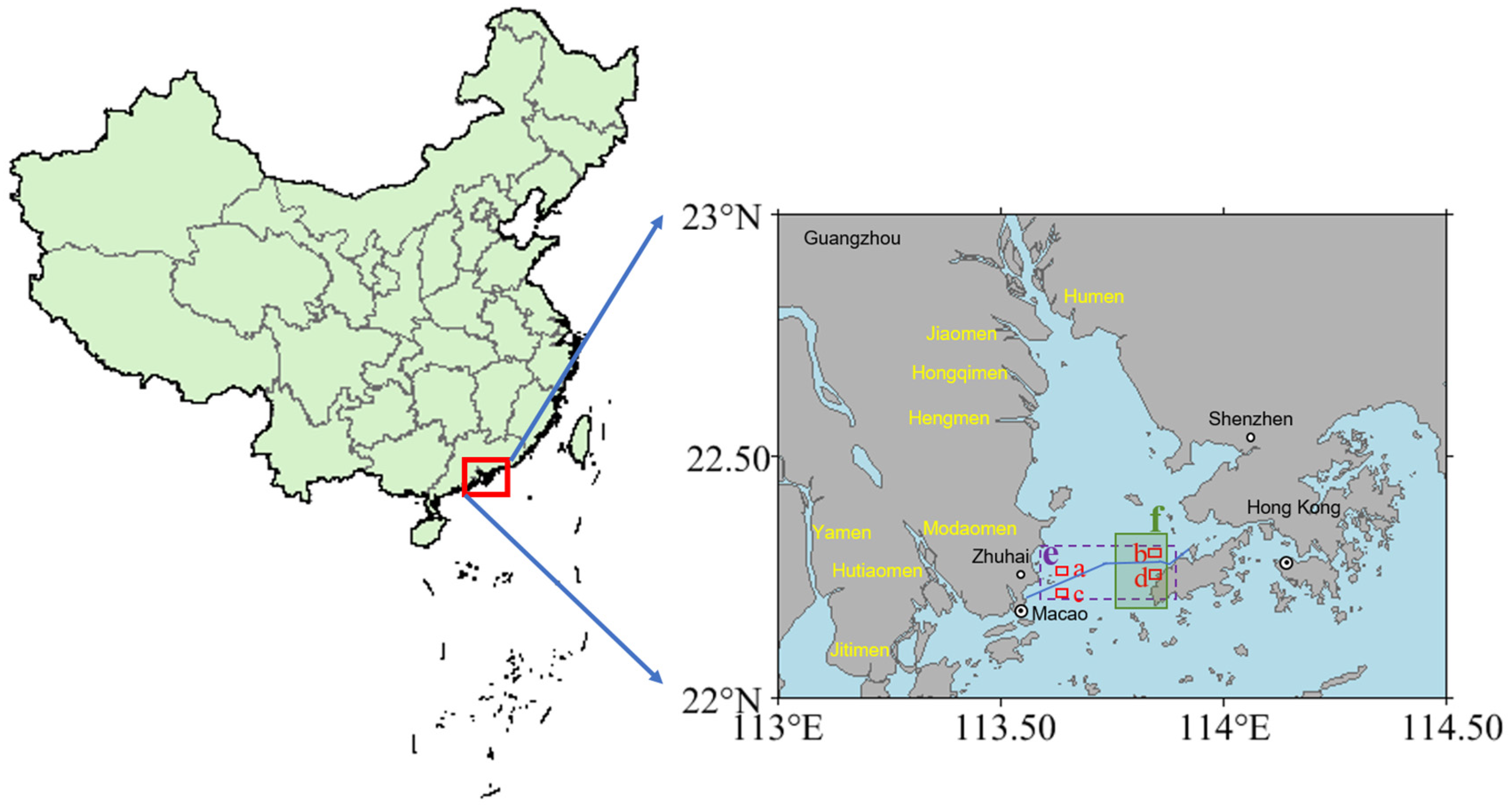

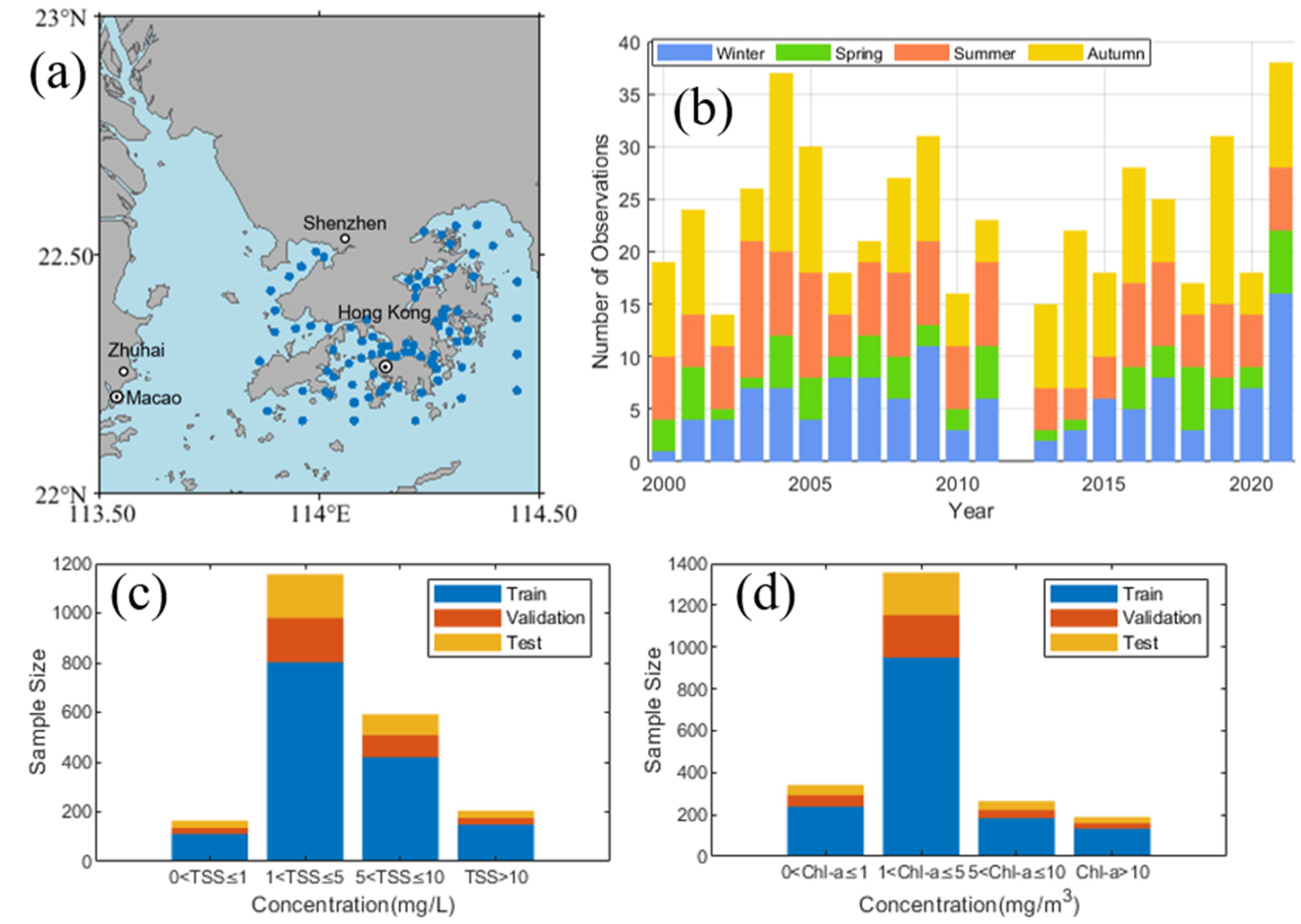



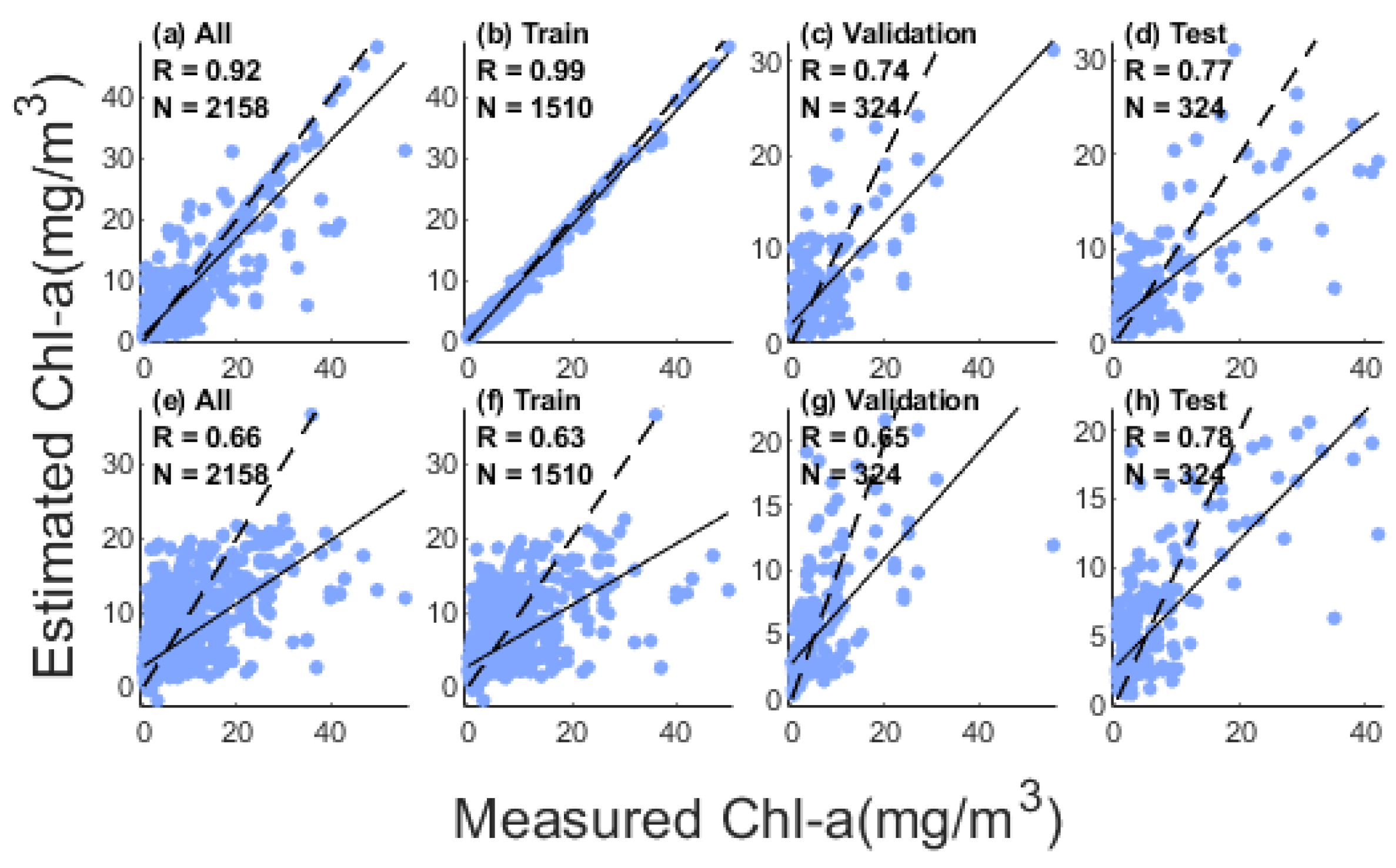

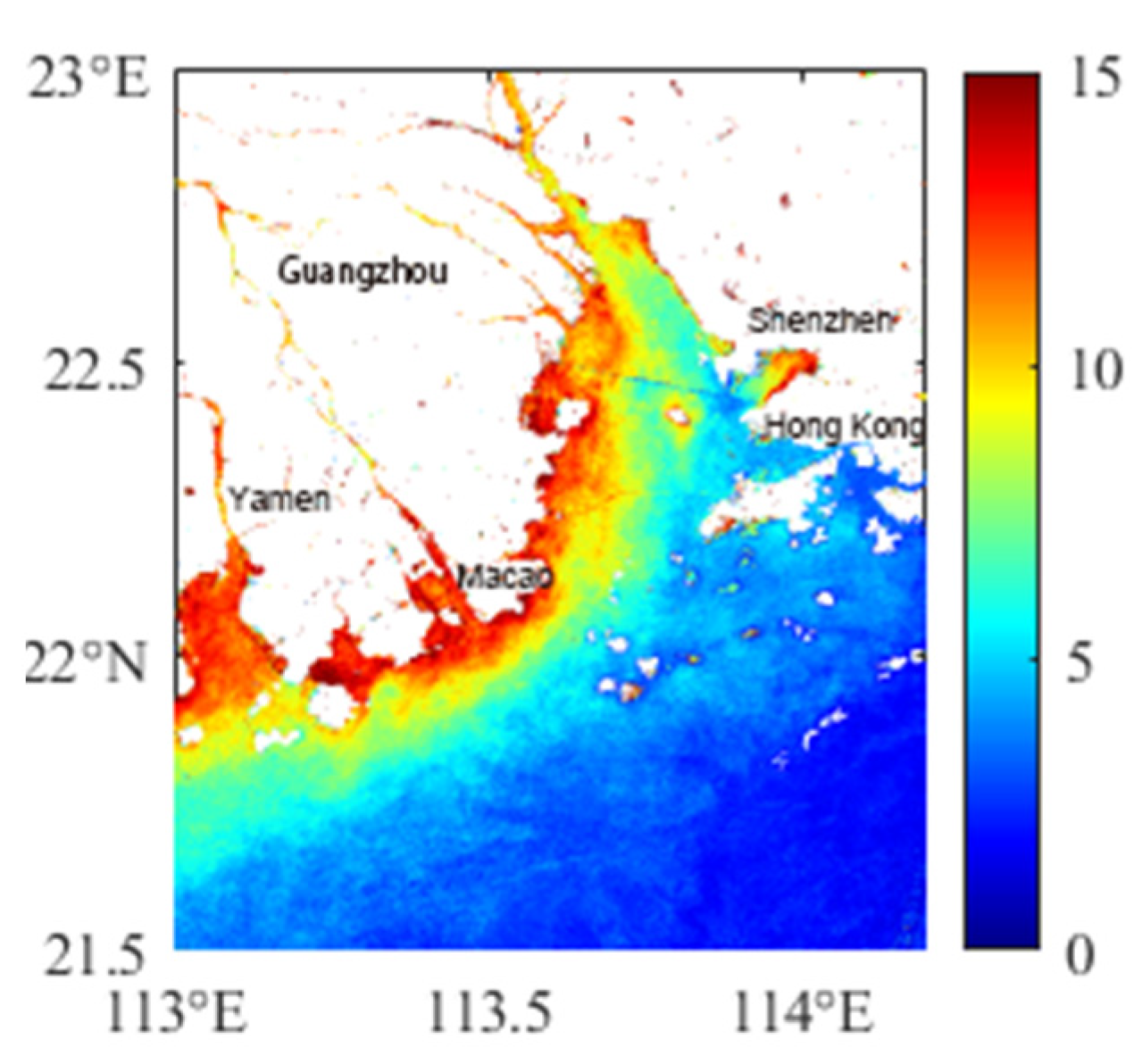
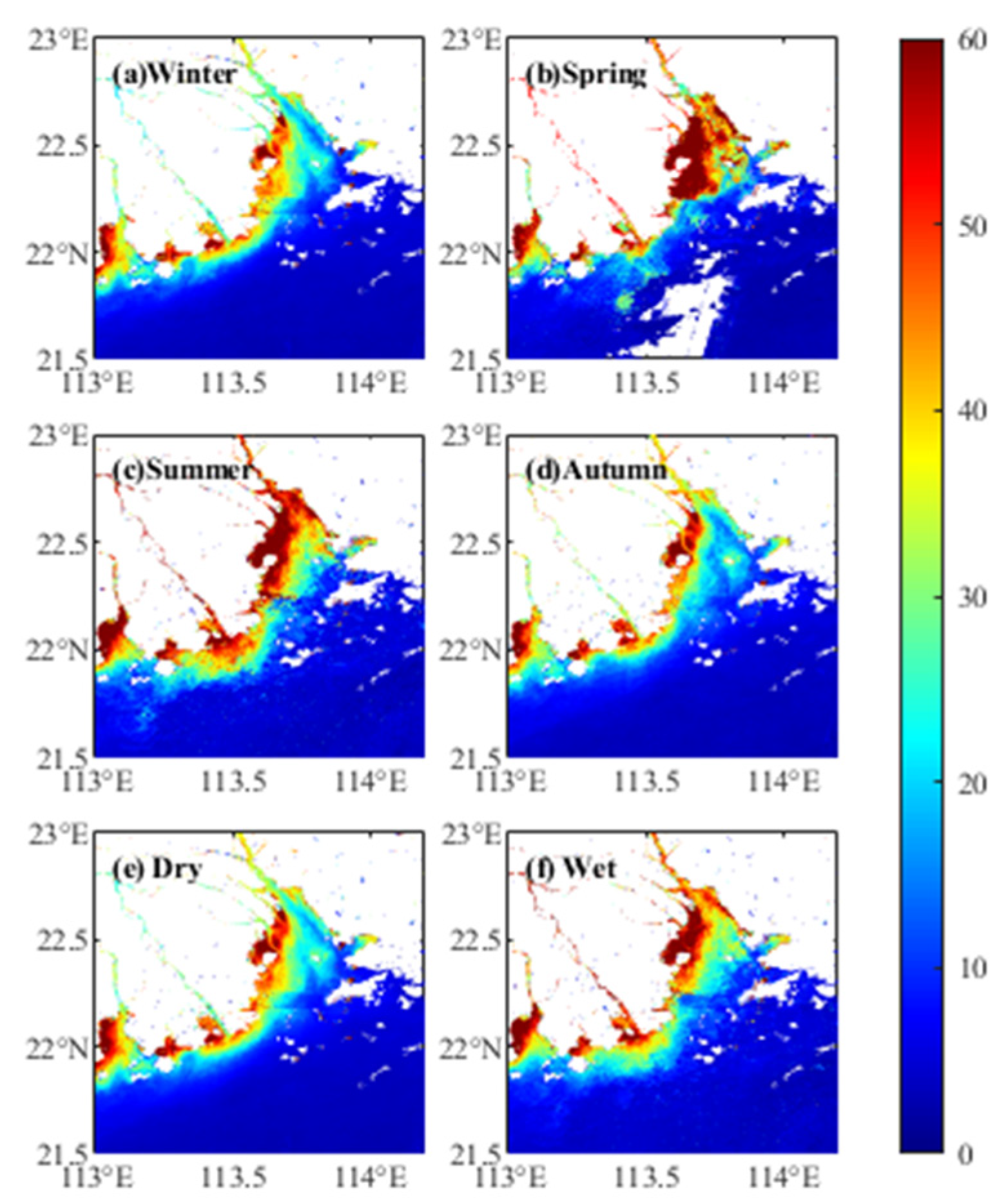

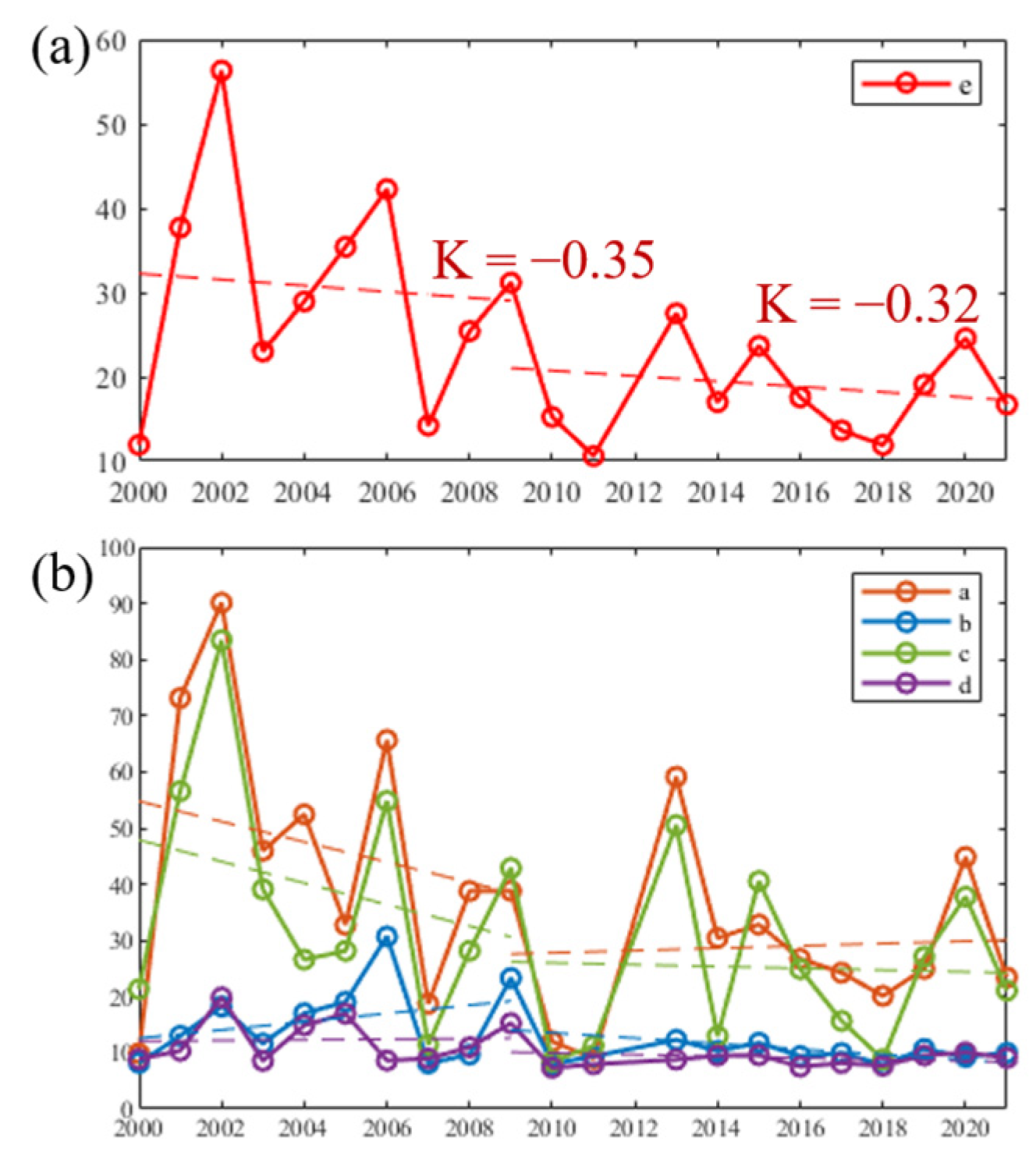

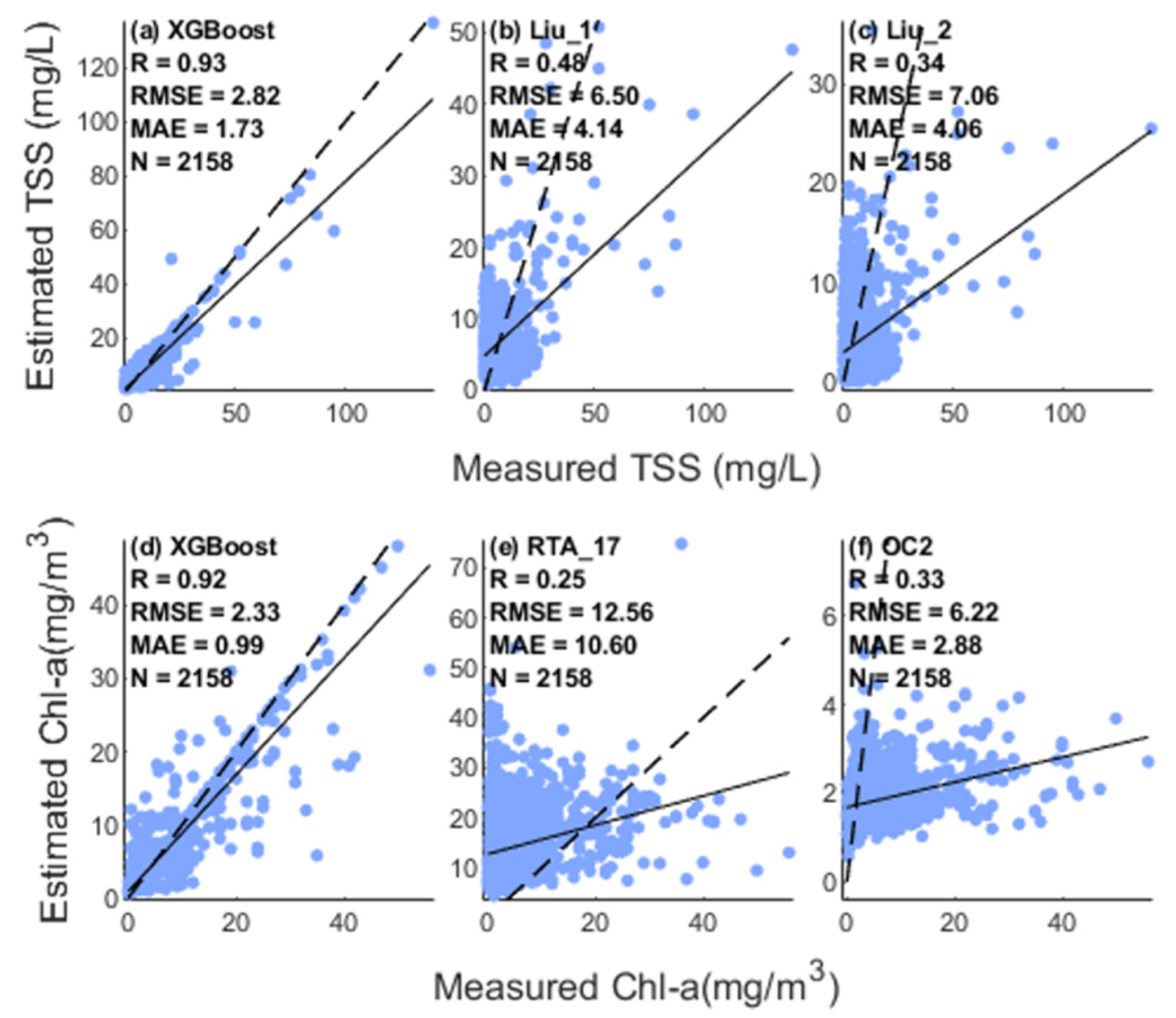
| Sensor | Band Reference Number | Band Name | Band Range (μm) | Spatial Resolution (m) | Revisit Cycle (Days) |
|---|---|---|---|---|---|
| Landsat 5 TM | B1 | Blue | 0.45–0.52 | 30 | 16 |
| B2 | Green | 0.52–0.60 | 30 | ||
| B3 | Red | 0.63–0.69 | 30 | ||
| B4 | NIR | 0.76–0.90 | 30 | ||
| B5 | SWIR | 1.55–1.75 | 30 | ||
| B6 | LWIR | 10.40–12.50 | 120 | ||
| B7 | SWIR | 2.08–2.35 | 30 | ||
| Landsat 8 OLI | B1 | Coastal | 0.43–0.45 | 30 | 16 |
| B2 | Blue | 0.45–0.52 | 30 | ||
| B3 | Green | 0.53–0.60 | 30 | ||
| B4 | Red | 0.63–0.68 | 30 | ||
| B5 | NIR | 0.85–0.89 | 30 | ||
| B6 | SWIR1 | 1.56–1.66 | 30 | ||
| B7 | SWIR2 | 2.10–2.30 | 30 | ||
| B8 | Pan | 0.50–0.68 | 15 | ||
| B9 | Cirrus | 1.36–1.39 | 30 |
| Band | Landsat 5 TM | Landsat 8 OLI |
|---|---|---|
| B1(Blue) | B1(Blue) | B2(Blue) |
| B2(Green) | B2(Green) | B3(Green) |
| B3(Red) | B3(Red) | B4(Red) |
| B4(NIR) | B4(NIR) | B5(NIR) |
| Parameter | Algorithm | Data Set | Sample Size | RMSE | R | MAE | R2 | Mean | Median |
|---|---|---|---|---|---|---|---|---|---|
| TSS | XGBoost | All | 2158 | 2.82 | 0.93 | 1.76 | 0.85 | 5.39 | 3.60 |
| Training | 1510 | 1.88 | 0.97 | 1.41 | 0.93 | 5.40 | 3.60 | ||
| Validation | 324 | 4.22 | 0.87 | 2.41 | 0.68 | 5.27 | 3.60 | ||
| Testing | 324 | 4.29 | 0.83 | 2.71 | 0.68 | 5.46 | 3.50 | ||
| BPNN | All | 2158 | 4.38 | 0.80 | 2.64 | 0.63 | 5.39 | 3.60 | |
| Training | 1510 | 4.08 | 0.82 | 2.58 | 0.67 | 5.40 | 3.60 | ||
| Validation | 324 | 4.35 | 0.84 | 2.60 | 0.66 | 5.27 | 3.60 | ||
| Testing | 324 | 5.57 | 0.70 | 2.97 | 0.46 | 5.46 | 3.50 | ||
| Chl-a | XGBoost | All | 2158 | 2.33 | 0.92 | 0.99 | 0.84 | 4.22 | 2.10 |
| Training | 1510 | 0.66 | 0.99 | 0.43 | 0.99 | 4.18 | 2.10 | ||
| Validation | 324 | 3.86 | 0.74 | 2.23 | 0.55 | 4.11 | 2.10 | ||
| Testing | 324 | 4.37 | 0.77 | 2.34 | 0.59 | 4.51 | 1.95 | ||
| BPNN | All | 2158 | 4.41 | 0.66 | 2.54 | 0.44 | 4.22 | 2.10 | |
| Training | 1510 | 4.41 | 0.63 | 2.56 | 0.40 | 4.18 | 2.10 | ||
| Validation | 324 | 4.37 | 0.65 | 2.43 | 0.42 | 4.11 | 2.10 | ||
| Testing | 324 | 4.47 | 0.78 | 2.56 | 0.57 | 4.51 | 1.95 |
| Parameter | Concentration | N | RMSE | RMSLE | MAE | MAPE (%) |
|---|---|---|---|---|---|---|
| TSS | 0 < TSS ≤ 2 | 550 | 1.71 | 0.54 | 1.44 | 133.23 |
| 2 < TSS ≤ 5 | 720 | 1.55 | 0.30 | 1.15 | 37.87 | |
| 5 < TSS ≤ 10 | 592 | 2.26 | 0.31 | 1.78 | 23.97 | |
| TSS > 10 | 205 | 7.15 | 0.43 | 4.74 | 26.52 | |
| Chl-a | 0 < Chl-a ≤ 1 | 341 | 1.55 | 0.48 | 0.92 | 147.18 |
| 1 < Chl-a ≤ 5 | 1357 | 1.14 | 0.25 | 0.59 | 29.58 | |
| 5 < Chl-a ≤ 10 | 263 | 2.70 | 0.35 | 1.52 | 20.29 | |
| Chl-a > 10 | 189 | 6.15 | 0.34 | 3.24 | 15.21 |
Disclaimer/Publisher’s Note: The statements, opinions and data contained in all publications are solely those of the individual author(s) and contributor(s) and not of MDPI and/or the editor(s). MDPI and/or the editor(s) disclaim responsibility for any injury to people or property resulting from any ideas, methods, instructions or products referred to in the content. |
© 2023 by the authors. Licensee MDPI, Basel, Switzerland. This article is an open access article distributed under the terms and conditions of the Creative Commons Attribution (CC BY) license (https://creativecommons.org/licenses/by/4.0/).
Share and Cite
Liu, J.; Qiu, Z.; Feng, J.; Wong, K.P.; Tsou, J.Y.; Wang, Y.; Zhang, Y. Monitoring Total Suspended Solids and Chlorophyll-a Concentrations in Turbid Waters: A Case Study of the Pearl River Estuary and Coast Using Machine Learning. Remote Sens. 2023, 15, 5559. https://doi.org/10.3390/rs15235559
Liu J, Qiu Z, Feng J, Wong KP, Tsou JY, Wang Y, Zhang Y. Monitoring Total Suspended Solids and Chlorophyll-a Concentrations in Turbid Waters: A Case Study of the Pearl River Estuary and Coast Using Machine Learning. Remote Sensing. 2023; 15(23):5559. https://doi.org/10.3390/rs15235559
Chicago/Turabian StyleLiu, Jiaxin, Zhongfeng Qiu, Jiajun Feng, Ka Po Wong, Jin Yeu Tsou, Yu Wang, and Yuanzhi Zhang. 2023. "Monitoring Total Suspended Solids and Chlorophyll-a Concentrations in Turbid Waters: A Case Study of the Pearl River Estuary and Coast Using Machine Learning" Remote Sensing 15, no. 23: 5559. https://doi.org/10.3390/rs15235559
APA StyleLiu, J., Qiu, Z., Feng, J., Wong, K. P., Tsou, J. Y., Wang, Y., & Zhang, Y. (2023). Monitoring Total Suspended Solids and Chlorophyll-a Concentrations in Turbid Waters: A Case Study of the Pearl River Estuary and Coast Using Machine Learning. Remote Sensing, 15(23), 5559. https://doi.org/10.3390/rs15235559







